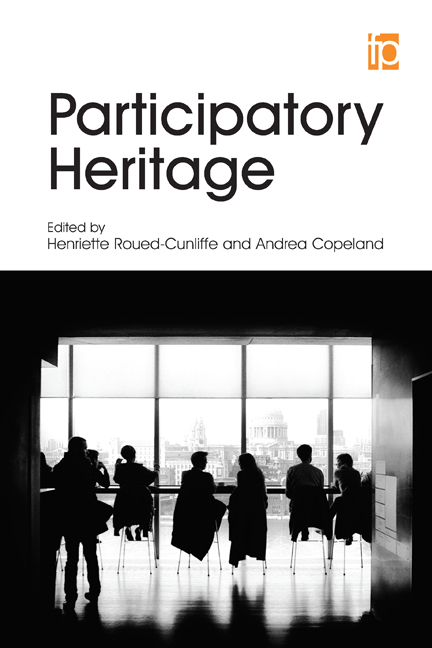Book contents
- Frontmatter
- Contents
- List of figures and tables
- Contributors
- Introduction: what is participatory heritage?
- Part 1 Participants
- Part 2 Challenges
- Part 3 Solutions
- 14 Ethiopian stories in an English landscape
- 15 Having a lovely time: localized crowdsourcing to create a 1930s street view of Bristol from a digitized postcard collection
- 16 Digital archiving in Canadian artist-run centres
- 17 New approaches to the community recording and preservation of burial space
- 18 A case for collaboration: solving practical problems in cultural heritage digitization projects
- 19 Open heritage data and APIs
- Further reading
- Index
18 - A case for collaboration: solving practical problems in cultural heritage digitization projects
from Part 3 - Solutions
Published online by Cambridge University Press: 08 June 2018
- Frontmatter
- Contents
- List of figures and tables
- Contributors
- Introduction: what is participatory heritage?
- Part 1 Participants
- Part 2 Challenges
- Part 3 Solutions
- 14 Ethiopian stories in an English landscape
- 15 Having a lovely time: localized crowdsourcing to create a 1930s street view of Bristol from a digitized postcard collection
- 16 Digital archiving in Canadian artist-run centres
- 17 New approaches to the community recording and preservation of burial space
- 18 A case for collaboration: solving practical problems in cultural heritage digitization projects
- 19 Open heritage data and APIs
- Further reading
- Index
Summary
COLLABORATION HAS BECOME a strategic priority at the University Library at the University of Saskatchewan, where we work. As collaboration increasingly becomes an institutional priority for other libraries and cultural heritage organizations, information professionals will be required to engage effectively in collaborative research; this chapter provides examples of and solutions to challenges posed by a wide-ranging, interinstitutional collaboration that will help to inform others who may undertake similar collaborative ventures.
Many celebrate the theoretical benefits of collaboration, citing such benefits as increased resources, sharing of expertise, pooled labour effort and increased project scope (Langley, Gray and Vaughan, 2006; Miller and Pellen, 2005; Williams, 2015). With these benefits of collaboration in mind, the Saskatchewan Ministry of Education, Provincial Library and Literacy Office approached the University Library at the University of Saskatchewan with an opportunity to lead a province-wide digitization initiative that would attempt to develop a sustainable framework for dramatically increasing the amount of Saskatchewan cultural heritage content available online. This resulted in a collaborative project called Saskatchewan History Online (SHO).
Increasingly professionals have been noticing another important aspect of collaboration: community. Community engagement is a key mission for SHO. William Miller (Miller and Pellen, 2005) writes, ‘there is growing under - standing of the key roles libraries have in the development of civil society, and … an obligation to enhance the integration of digital information … much more broadly throughout all levels of society’ (p. 3). Community integration with GLAMs (galleries, libraries, archives and museums) and other memory institutions, along with the ‘citizens of Saskatchewan’ (the target audience for SHO) is instrumental to the conception of the SHO project. This type of community-involved project developed within a university institution is becoming somewhat more common and certainly more strategically important, as outlined in the executive summary of Leading the Digital World: opportunities for Canada's memory institutions (Council of Canadian Academies, 2015): ‘memory institutions are beginning to realize that digital projects, which may be national or even international, must establish roots in the community in order to succeed’ (p. xiv).
The many theoretical benefits to collaboration on a large-scope project gave us great enthusiasm about the potential outcomes from such an initiative. Like Anne Langley, Edward Gray and K. T. L. Vaughan (2006), we were embarking on the project with the attitude that ‘collaboration is a win-win adventure’ (p. 9).
- Type
- Chapter
- Information
- Participatory Heritage , pp. 185 - 194Publisher: FacetPrint publication year: 2017



